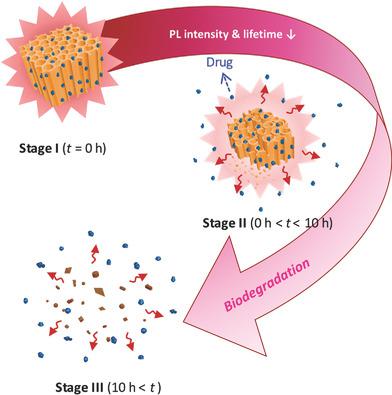当前位置:
X-MOL 学术
›
Adv. Mater.
›
论文详情
Our official English website, www.x-mol.net, welcomes your
feedback! (Note: you will need to create a separate account there.)
Tracking the Fate of Porous Silicon Nanoparticles Delivering a Peptide Payload by Intrinsic Photoluminescence Lifetime
Advanced Materials ( IF 27.4 ) Pub Date : 2018-07-13 , DOI: 10.1002/adma.201802878 Yusung Jin 1, 2 , Dokyoung Kim 3 , Hajung Roh 1, 4 , Sojeong Kim 1, 5 , Sazid Hussain 6 , Jinyoung Kang 7 , Chan-Gi Pack 2 , Jun Ki Kim 1, 2 , Seung-Jae Myung 8 , Erkki Ruoslahti 6, 9 , Michael J Sailor 7 , Song Cheol Kim 1, 10 , Jinmyoung Joo 1, 2
Advanced Materials ( IF 27.4 ) Pub Date : 2018-07-13 , DOI: 10.1002/adma.201802878 Yusung Jin 1, 2 , Dokyoung Kim 3 , Hajung Roh 1, 4 , Sojeong Kim 1, 5 , Sazid Hussain 6 , Jinyoung Kang 7 , Chan-Gi Pack 2 , Jun Ki Kim 1, 2 , Seung-Jae Myung 8 , Erkki Ruoslahti 6, 9 , Michael J Sailor 7 , Song Cheol Kim 1, 10 , Jinmyoung Joo 1, 2
Affiliation

|
A nanoparticle system for systemic delivery of therapeutics is described, which incorporates a means of tracking the fate of the nanocarrier and its residual drug payload in vivo by photoluminescence (PL). Porous silicon nanoparticles (PSiNPs) containing the proapoptotic antimicrobial peptide payload, D[KLAKLAK]2, are monitored by measurement of the intrinsic PL intensity and the PL lifetime of the nanoparticles. The PL lifetime of the PSiNPs is on the order of microseconds, substantially longer than the nanosecond lifetimes typically exhibited by conventional fluorescent tags or by autofluorescence from cells and tissues; thus, emission from the nanoparticles is readily discerned in the time‐resolved PL spectrum. It is found that the luminescence lifetime of the PSiNP host decreases as the nanoparticle dissolves in phosphate‐buffered saline solution (37 °C), and this correlates with the extent of release of the peptide payload. The time‐resolved PL measurement allows tracking of the in vivo fate of PSiNPs injected (via tail vein) into mice. Clearance of the nanoparticles through the liver, kidneys, and lungs of the animals is observed. The luminescence lifetime of the PSiNPs decreases with increasing residence time in the mice, providing a measure of half‐life for degradation of the drug nanocarriers.
中文翻译:

通过本征光致发光寿命追踪提供肽有效负载的多孔硅纳米粒子的命运
描述了一种用于全身递送治疗剂的纳米粒子系统,该系统结合了通过光致发光(PL)跟踪纳米载体及其体内残留药物有效负载的命运的方法。通过测量纳米颗粒的内在 PL 强度和 PL 寿命来监测含有促凋亡抗微生物肽有效负载D [KLAKLAK] 2的多孔硅纳米颗粒 (PSiNP)。 PSiNP 的 PL 寿命约为微秒,远长于传统荧光标签或细胞和组织自发荧光通常表现出的纳秒寿命;因此,在时间分辨 PL 光谱中很容易辨别纳米粒子的发射。研究发现,随着纳米颗粒溶解在磷酸盐缓冲盐水溶液(37°C)中,PSiNP 主体的发光寿命会缩短,这与肽有效负载的释放程度相关。时间分辨 PL 测量可以追踪(通过尾静脉)注射到小鼠体内的 PSiNP 的体内命运。观察纳米颗粒通过动物肝脏、肾脏和肺的清除情况。 PSiNPs 的发光寿命随着在小鼠体内停留时间的增加而缩短,从而提供了药物纳米载体降解半衰期的衡量标准。
更新日期:2018-07-13
中文翻译:

通过本征光致发光寿命追踪提供肽有效负载的多孔硅纳米粒子的命运
描述了一种用于全身递送治疗剂的纳米粒子系统,该系统结合了通过光致发光(PL)跟踪纳米载体及其体内残留药物有效负载的命运的方法。通过测量纳米颗粒的内在 PL 强度和 PL 寿命来监测含有促凋亡抗微生物肽有效负载D [KLAKLAK] 2的多孔硅纳米颗粒 (PSiNP)。 PSiNP 的 PL 寿命约为微秒,远长于传统荧光标签或细胞和组织自发荧光通常表现出的纳秒寿命;因此,在时间分辨 PL 光谱中很容易辨别纳米粒子的发射。研究发现,随着纳米颗粒溶解在磷酸盐缓冲盐水溶液(37°C)中,PSiNP 主体的发光寿命会缩短,这与肽有效负载的释放程度相关。时间分辨 PL 测量可以追踪(通过尾静脉)注射到小鼠体内的 PSiNP 的体内命运。观察纳米颗粒通过动物肝脏、肾脏和肺的清除情况。 PSiNPs 的发光寿命随着在小鼠体内停留时间的增加而缩短,从而提供了药物纳米载体降解半衰期的衡量标准。









































 京公网安备 11010802027423号
京公网安备 11010802027423号